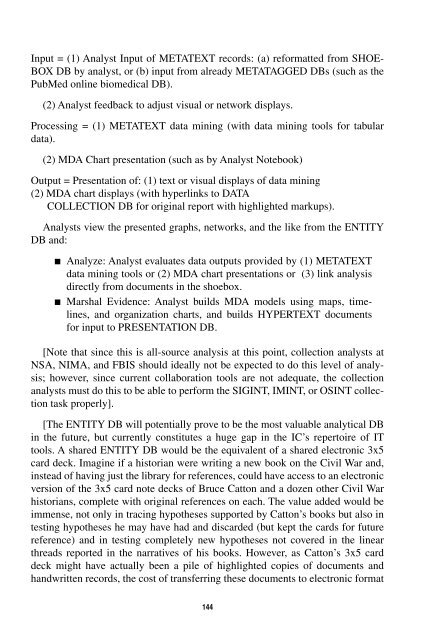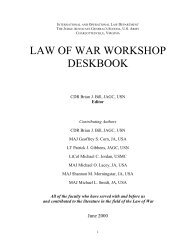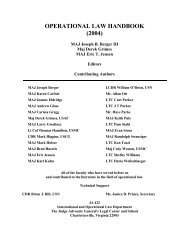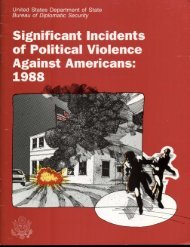Warning Analysis for the Information Age - Higgins Counterterrorism ...
Warning Analysis for the Information Age - Higgins Counterterrorism ...
Warning Analysis for the Information Age - Higgins Counterterrorism ...
You also want an ePaper? Increase the reach of your titles
YUMPU automatically turns print PDFs into web optimized ePapers that Google loves.
Input = (1) Analyst Input of METATEXT records: (a) re<strong>for</strong>matted from SHOE-BOX DB by analyst, or (b) input from already METATAGGED DBs (such as <strong>the</strong>PubMed online biomedical DB).(2) Analyst feedback to adjust visual or network displays.Processing = (1) METATEXT data mining (with data mining tools <strong>for</strong> tabulardata).(2) MDA Chart presentation (such as by Analyst Notebook)Output = Presentation of: (1) text or visual displays of data mining(2) MDA chart displays (with hyperlinks to DATACOLLECTION DB <strong>for</strong> original report with highlighted markups).Analysts view <strong>the</strong> presented graphs, networks, and <strong>the</strong> like from <strong>the</strong> ENTITYDB and:■ Analyze: Analyst evaluates data outputs provided by (1) METATEXTdata mining tools or (2) MDA chart presentations or (3) link analysisdirectly from documents in <strong>the</strong> shoebox.■ Marshal Evidence: Analyst builds MDA models using maps, timelines,and organization charts, and builds HYPERTEXT documents<strong>for</strong> input to PRESENTATION DB.[Note that since this is all-source analysis at this point, collection analysts atNSA, NIMA, and FBIS should ideally not be expected to do this level of analysis;however, since current collaboration tools are not adequate, <strong>the</strong> collectionanalysts must do this to be able to per<strong>for</strong>m <strong>the</strong> SIGINT, IMINT, or OSINT collectiontask properly].[The ENTITY DB will potentially prove to be <strong>the</strong> most valuable analytical DBin <strong>the</strong> future, but currently constitutes a huge gap in <strong>the</strong> IC’s repertoire of ITtools. A shared ENTITY DB would be <strong>the</strong> equivalent of a shared electronic 3x5card deck. Imagine if a historian were writing a new book on <strong>the</strong> Civil War and,instead of having just <strong>the</strong> library <strong>for</strong> references, could have access to an electronicversion of <strong>the</strong> 3x5 card note decks of Bruce Catton and a dozen o<strong>the</strong>r Civil Warhistorians, complete with original references on each. The value added would beimmense, not only in tracing hypo<strong>the</strong>ses supported by Catton’s books but also intesting hypo<strong>the</strong>ses he may have had and discarded (but kept <strong>the</strong> cards <strong>for</strong> futurereference) and in testing completely new hypo<strong>the</strong>ses not covered in <strong>the</strong> linearthreads reported in <strong>the</strong> narratives of his books. However, as Catton’s 3x5 carddeck might have actually been a pile of highlighted copies of documents andhandwritten records, <strong>the</strong> cost of transferring <strong>the</strong>se documents to electronic <strong>for</strong>mat144
















